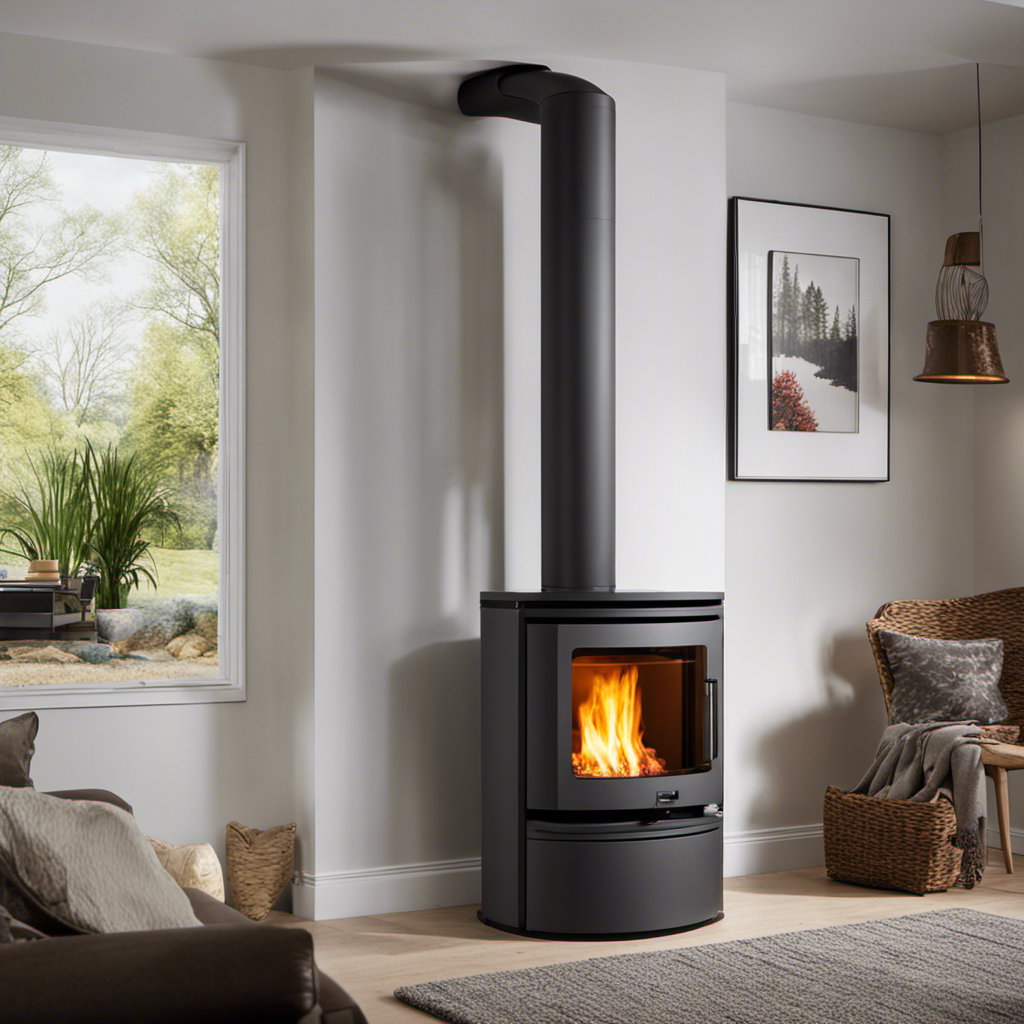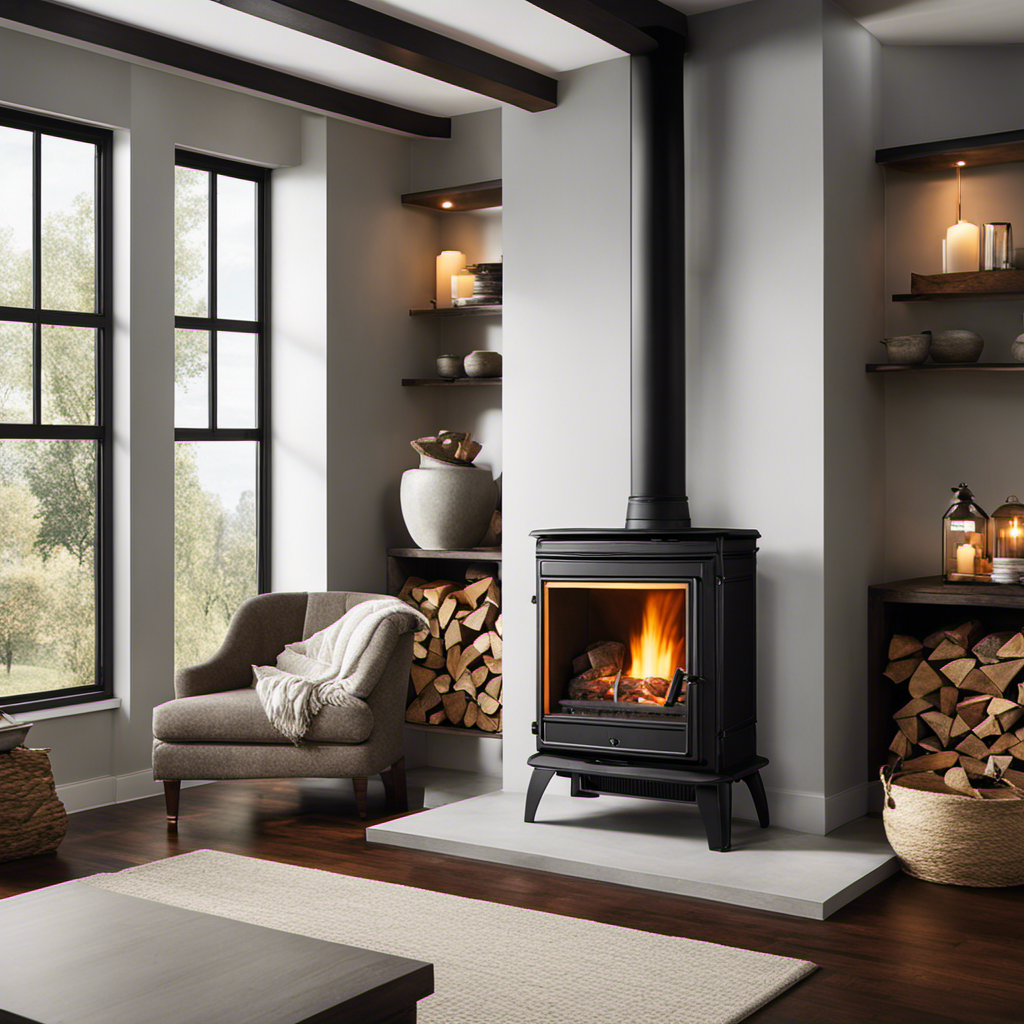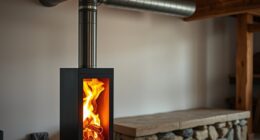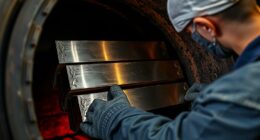I’ve always had a keen interest in various heating techniques, and it wasn’t until recently that I discovered the idea of heating using a wood pellet stove. Intrigued by its potential advantages, I started to explore the features and functionalities of wood pellet stoves in detail.
In this article, we will explore the history, functionality, types, installation process, and maintenance tips for wood pellet stoves. Additionally, we’ll compare them to other heating options to help you make an informed decision.
So let’s dive in and discover the world of wood pellet stoves together!
Key Takeaways
- Wood pellet stoves are a renewable energy source that emerged in the 1970s in response to high oil prices.
- Wood pellet stoves burn wood pellets in a combustion chamber to produce heat, providing consistent and cost-effective heating.
- Wood pellet stoves have a lower environmental impact compared to traditional stoves, emitting fewer greenhouse gas emissions and pollutants.
- Wood pellet stoves are efficient and cost-effective, with locally sourced biomass materials reducing energy costs and benefiting the economy.
History of Wood Pellet Stoves
You’ll be surprised to learn about the fascinating history of wood pellet stoves.
The history of pellet production dates back to the 1970s when oil prices skyrocketed, leading to a demand for alternative heating sources. Wood pellets emerged as an efficient and environmentally friendly option.
These small, cylindrical fuel sources are made from compressed sawdust or other biomass materials. Wood pellet fuel offers several advantages over traditional fuels such as coal or gas. They produce less ash and emissions, making them cleaner and more sustainable.
In addition, wood pellets are readily available, affordable, and can be produced from renewable resources.
With this understanding of the history of wood pellet production and its many advantages, let’s delve into how these stoves actually work without relying on fossil fuels or electricity.
How Wood Pellet Stoves Work
When it comes to understanding how wood pellet stoves work, there are a few key points to consider.
First, the combustion process is an essential aspect of these stoves, as it involves burning wood pellets to produce heat.
Second, wood pellets are considered a renewable energy source because they are made from compressed sawdust and other wood waste materials.
Lastly, wood pellet stoves are known for their efficiency and cost-effectiveness due to their ability to generate consistent heat while using fewer resources compared to traditional heating methods.
Combustion Process Explained
The combustion process in a wood pellet stove involves the burning of compressed wood pellets to produce heat. Wood pellets are made from compacted sawdust and other biomass materials, making them an environmentally friendly fuel source. When the pellets are fed into the stove’s combustion chamber, they ignite and release heat energy through a controlled burn. This process is efficient and provides several benefits:
-
Reduced carbon emissions: Wood pellets have lower carbon emissions compared to traditional fossil fuels like coal or oil.
-
Renewable energy source: Wood pellets come from sustainable sources such as forest residues or dedicated biomass crops, making them a renewable energy option.
-
Cost-effective heating: Wood pellet stoves can be more cost-effective than other heating methods, especially when using locally sourced pellets.
Transitioning into the next section about ‘renewable energy source,’ it is important to consider the long-term sustainability of wood pellet stoves and their contribution to reducing reliance on fossil fuels.
Renewable Energy Source
Using locally sourced biomass materials for fuel in your stove provides a renewable energy option. Wood pellets, made from compacted sawdust and other wood waste, are an excellent choice for this purpose.
Not only do they offer a sustainable alternative to fossil fuels, but they also have several environmental benefits. A comprehensive environmental impact analysis shows that wood pellet stoves produce significantly fewer greenhouse gas emissions compared to traditional heating methods.
Additionally, the use of biomass materials helps reduce landfill waste by utilizing materials that would otherwise be discarded. This renewable energy efficiency not only saves you money on utility bills but also contributes to a cleaner and healthier environment.
Moving forward, let’s explore the efficiency and cost-effectiveness of wood pellet stoves as an energy source without wasting any time.
Efficiency and Cost-Effectiveness
To maximize efficiency and save money, you should consider the cost-effectiveness of utilizing locally sourced biomass materials for fuel in your stove. Here are four reasons why this is a smart choice:
-
Energy savings: Using biomass materials like wood pellets can significantly reduce your energy costs compared to traditional fossil fuels.
-
Carbon footprint reduction: Biomass fuels produce lower carbon emissions compared to fossil fuels, helping to reduce your overall carbon footprint.
-
Sustainable option: Locally sourced biomass materials come from renewable sources, making them a sustainable and environmentally friendly fuel choice.
-
Economic benefits: Supporting local biomass suppliers not only helps the environment but also boosts the local economy by creating jobs and supporting small businesses.
Benefits of Using a Wood Pellet Stove
One of the benefits of a wood pellet stove is that it can help reduce heating costs. Wood pellets are an affordable and efficient source of fuel, making them more cost-effective compared to traditional heating methods. Additionally, wood pellet stoves have a higher combustion efficiency, which means they produce more heat from less fuel. This not only saves money but also reduces carbon emissions.
Wood pellets are made from renewable resources and have a lower carbon footprint compared to fossil fuels like oil or gas. Furthermore, wood pellet stoves offer convenience and ease of use. They typically have automatic ignition systems and adjustable temperature controls, making them user-friendly for all homeowners.
With these advantages in mind, let’s now explore the different types of wood pellet stoves available on the market today.
Types of Wood Pellet Stoves
When discussing wood pellet stoves, it’s important to consider the efficiency of different types. Efficiency can vary depending on factors such as heat output and fuel consumption rates.
Another important factor to consider is the cost and maintenance involved. This includes upfront costs, operational expenses, and regular cleaning and maintenance requirements.
Lastly, it’s crucial to think about the environmental impact of wood pellet stoves. This includes the emissions produced during operation and the sustainability of wood pellets as a fuel source.
Overall, considering these factors will help you make an informed decision when choosing a wood pellet stove.
Efficiency of Different Types
You can increase the efficiency of different types of wood pellet stoves by properly maintaining and cleaning them regularly. Here are three ways to improve their performance:
-
Choose the right type of fuel: Opt for high-quality wood pellets that have a low moisture content and minimal additives. This will ensure cleaner combustion and better energy efficiency.
-
Clean the stove regularly: Remove ash buildup from the burn pot, heat exchanger, and flue pipes. A clean stove allows for better airflow, which improves combustion efficiency.
-
Schedule professional maintenance: Have a certified technician inspect your wood pellet stove annually. They can identify any issues that may be affecting its efficiency, such as worn-out gaskets or faulty sensors.
By following these steps, you can maximize the energy efficiency of your wood pellet stove and reduce fuel consumption.
Now let’s delve into the cost and maintenance aspect of owning a wood pellet stove…
Cost and Maintenance
To keep your wood pellet stove operating efficiently, it’s important to consider the cost and maintenance involved. Wood pellet stoves require regular maintenance to ensure optimal performance and longevity. This includes cleaning the stove and chimney regularly, inspecting and replacing parts as needed, and ensuring proper fuel storage.
When considering the cost analysis for wood pellet stoves, it’s crucial to factor in both the initial investment and ongoing expenses. The initial cost of a wood pellet stove can vary depending on the size and features, but generally ranges from $1,500 to $3,500. Additionally, you need to budget for purchasing wood pellets which typically cost around $200 to $300 per ton.
To provide a clear overview of the costs associated with wood pellet stoves, here is a sample breakdown:
| Cost | Amount |
|---|---|
| Initial Investment | $2,000 |
| Annual Maintenance | $150 |
| Pellet Fuel (per year) | $300 |
Considering these factors will help you make an informed decision about whether a wood pellet stove is a viable heating option for your home.
Now let’s move on to discussing environmental impact considerations when using a wood pellet stove.
Environmental Impact Considerations
Considering the environmental impact is important when deciding on a heating option for your home. One heating option that has gained popularity in recent years is the wood pellet stove. Wood pellets are made from compressed sawdust and other wood waste, making them a renewable source of energy. When it comes to carbon footprint, wood pellet stoves emit significantly less carbon dioxide compared to traditional wood-burning stoves or fossil fuel-based heating systems. This helps reduce greenhouse gas emissions and combat climate change. Additionally, wood pellet stoves produce fewer pollutants such as particulate matter, nitrogen oxides, and volatile organic compounds, resulting in improved air quality both indoors and outdoors. Considering these factors, a wood pellet stove can be an eco-friendly choice for heating your home.
When considering factors to keep in mind when choosing a wood pellet stove, there are several important aspects to consider.
Factors to Consider When Choosing a Wood Pellet Stove
When choosing a wood pellet stove, it’s important to consider factors such as size, efficiency, and maintenance requirements. Size refers to the heating capacity of the stove and should be chosen based on the size of the area you want to heat. Efficiency determines how effectively the stove converts pellets into heat, with higher efficiency models providing more heat per pellet. Maintenance requirements include cleaning out ash regularly and scheduling professional inspections for optimal performance. Here is a table summarizing the advantages and disadvantages of wood pellet stoves:
| Advantages | Disadvantages |
|---|---|
| Renewable fuel | Initial cost |
| Lower emissions | Dependence on pellets |
| Automated system | Noise during operation |
Considering these factors will help you make an informed decision when selecting a wood pellet stove that best suits your needs. In terms of installation and maintenance of wood pellet stoves…
Installation and Maintenance of Wood Pellet Stoves
Installation and maintenance of wood pellet stoves can be simplified with regular cleaning and professional inspections. When installing a wood pellet stove, there are a few tips to keep in mind.
First, choose a location that is safe and allows for proper ventilation. It’s important to follow the manufacturer’s guidelines for clearance distances from walls and other combustible materials. Additionally, make sure the stove is properly connected to the chimney or vent system to ensure efficient operation.
Regular cleaning is essential for optimal performance. Cleaning the ash pan regularly helps prevent clogs and ensures proper airflow. It’s also important to clean the exhaust vents and flue pipe to remove any buildup or obstructions.
If you encounter any issues with your wood pellet stove, troubleshooting common problems can help resolve them quickly. Some common issues include ignition failure, poor heat output, or abnormal noises. Checking the fuel supply, inspecting the igniter, and cleaning the burn pot are some troubleshooting steps you can take.
Transition: Now that we have covered installation tips and maintenance advice for wood pellet stoves, let’s move on to comparing them with other heating options available in the market today.
Comparing Wood Pellet Stoves to Other Heating Options
To compare wood pellet stoves to other heating options, you should consider factors such as efficiency, cost-effectiveness, and environmental impact. Wood pellet stoves are known for their renewable energy benefits and low environmental impact. They are highly efficient, with an average efficiency rating of 80% to 90%, which means they convert a large portion of the fuel into heat. In terms of cost-effectiveness, wood pellets tend to be cheaper than fossil fuels like oil or gas. Additionally, wood pellets are made from waste materials such as sawdust or agricultural residues, making them a sustainable and renewable energy source.
| Factor | Wood Pellet Stove | Oil Heating | Electric Heating |
|---|---|---|---|
| Efficiency | 80%-90% | 60%-85% | 100% |
| Cost-Effectiveness | Affordable | Expensive | Expensive |
| Environmental Impact Considerations | Low emissions | High emissions | No direct emissions |
Considering these factors, it is clear that wood pellet stoves offer a compelling alternative for heating homes efficiently and with minimal environmental impact. Now let’s delve into tips for efficiently using a wood pellet stove without wasting any heat.
Tips for Efficiently Using a Wood Pellet Stove
Using a wood pellet stove efficiently can help maximize heat output and minimize waste. To achieve this, there are several efficient heating techniques to keep in mind.
Firstly, using high-quality pellets that have a low moisture content and are made from hardwood can significantly increase efficiency. Additionally, regularly cleaning the stove’s components such as the burn pot and ash pan helps maintain optimal performance.
It is also important to properly adjust the air intake settings to control the amount of oxygen entering the combustion chamber. Troubleshooting common issues with wood pellet stoves involves checking for any blockages in the venting system or exhaust pipe and ensuring that the auger is functioning correctly.
Frequently Asked Questions
Are Wood Pellet Stoves Environmentally Friendly?
Yes, wood pellet stoves are environmentally friendly. They have a high efficiency and produce a low carbon footprint compared to traditional heating methods. They use renewable biomass fuel made from compressed sawdust or wood chips.
How Often Do Wood Pellet Stoves Need to Be Cleaned?
Wood pellet stove maintenance is essential to ensure optimal performance. Regular cleaning is recommended to remove ash and creosote buildup. Best practices include inspecting and cleaning the burn pot, heat exchanger, and chimney annually.
Can Wood Pellet Stoves Be Used as the Primary Heat Source in a Home?
Wood pellet stoves can be used as the primary heat source in a home. They are highly efficient, providing warmth without the hassle of traditional fireplaces. The benefits include cost savings and a reduced carbon footprint.
What Is the Average Cost of Operating a Wood Pellet Stove?
The average cost of operating a wood pellet stove depends on factors such as the price of pellets and the energy efficiency of the stove. A cost comparison can help determine the most economical option.
Are Wood Pellet Stoves Suitable for People With Respiratory Issues?
I have respiratory issues, so I wondered if wood pellet stoves would be suitable for me. After researching, I found some maintenance tips and learned about the benefits of using wood pellet stoves for heating.
Conclusion
In conclusion, after conducting extensive research on wood pellet stoves, I can confidently say that they are a fantastic heating option for any home.
Their history dates back several decades, and their operation is both efficient and environmentally friendly. The benefits of using a wood pellet stove are numerous, including cost savings and reduced carbon emissions.
When choosing a wood pellet stove, it’s important to consider factors such as size and heat output. Installation and maintenance may require professional assistance.
Comparing wood pellet stoves to other heating options reveals their superiority in terms of sustainability and convenience.
To maximize efficiency, remember the idiom ‘burning the midnight oil’ by regularly cleaning and maintaining your wood pellet stove.











